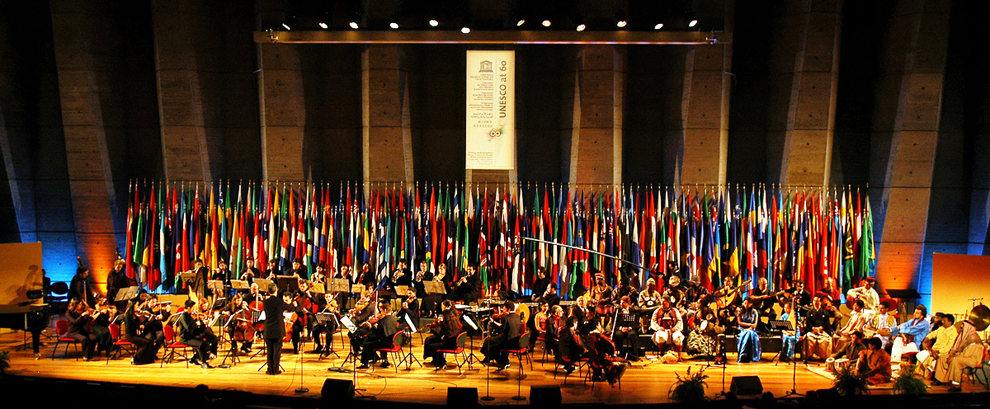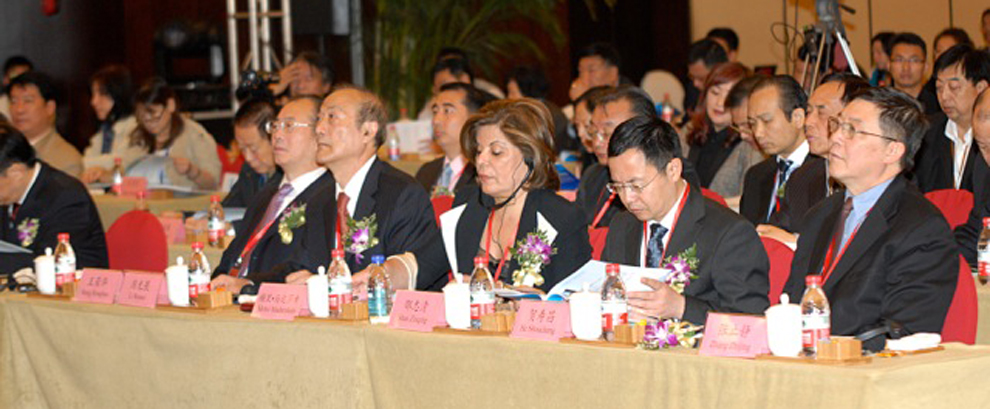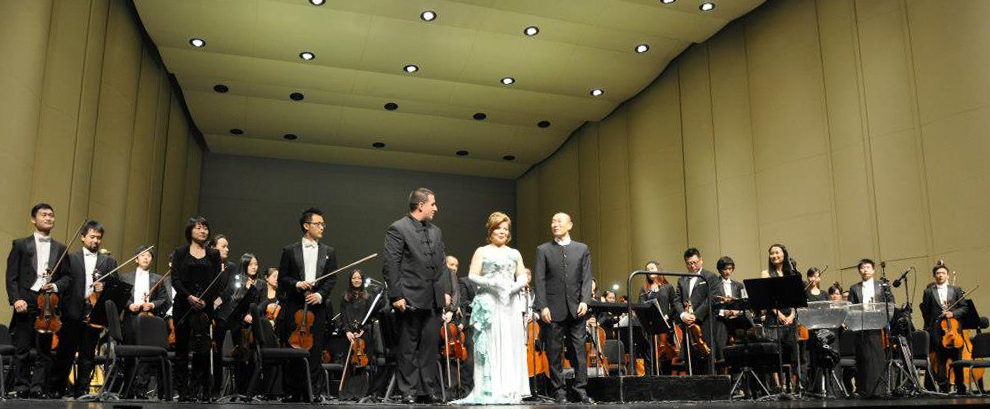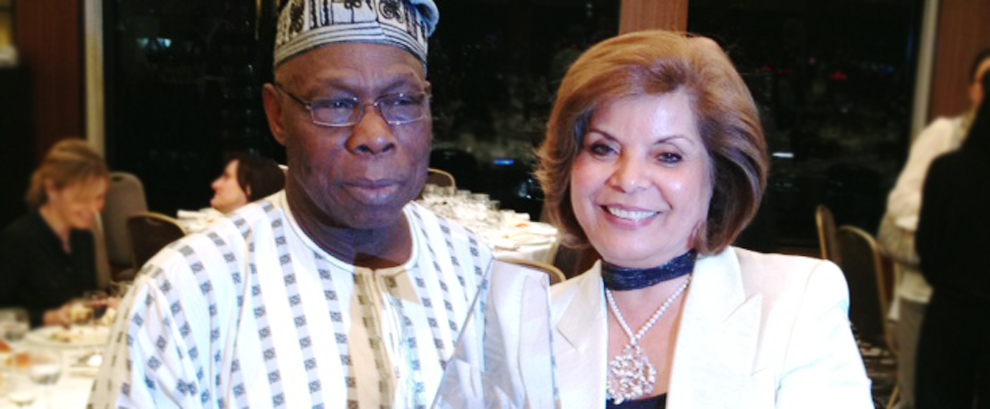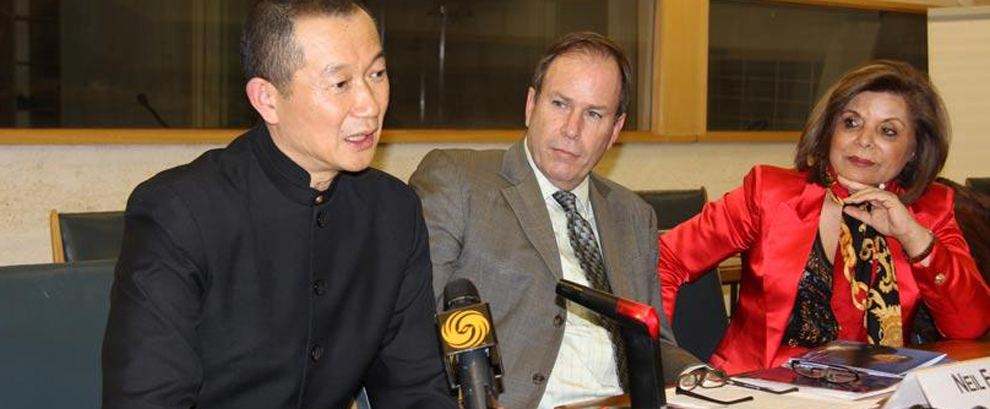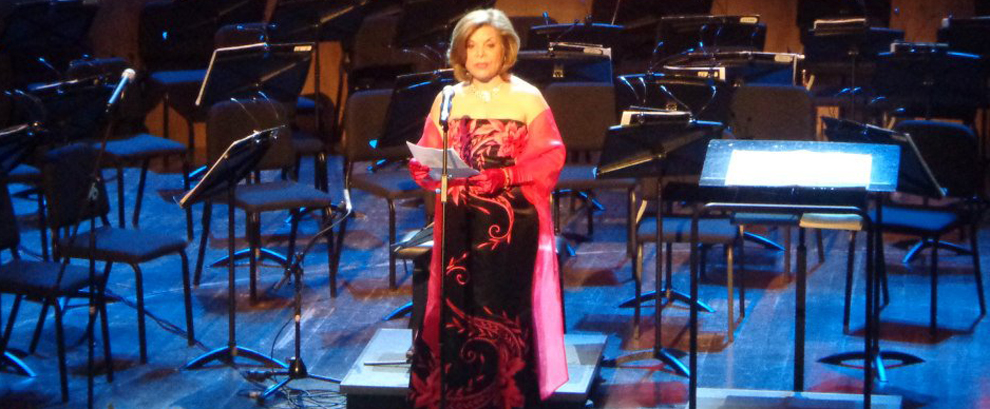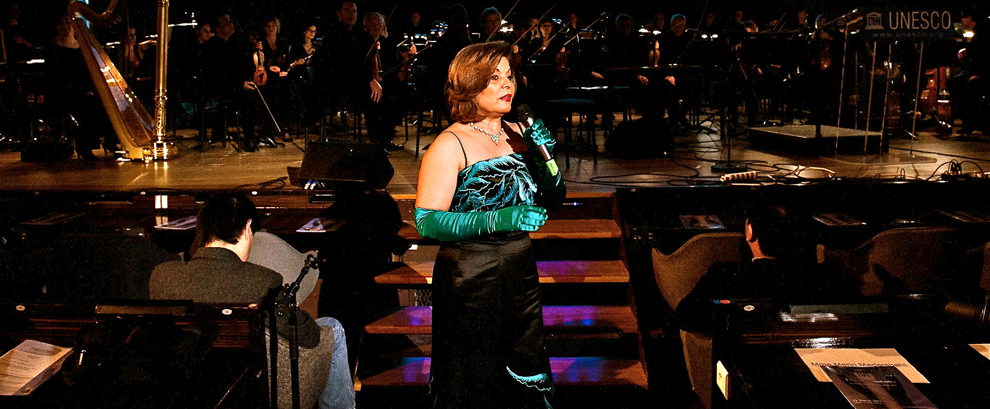International Forum on Creative City and Industries
October 26-28, 2011
Shanghai, China
Statement by Mehri Madarshahi
President, Melody for Dialogue Association
Good morning, Excellencies, Ladies and Gentlemen,
It is a great privilege for me to attend this meeting and speak about the importance of bridging the gap between local and global culture in the post industrial economy.
Let me start with an obvious question:
Why do cities matter in the creative economy? Cities are where, throughout history, artists, intellectuals, scientists and all other creative actors have gathered and lived in close vicinity, influencing each others. There is an organic relationship between creativeness and cities, which are considered the cradle of civilization and cosmopolitanism, all words originally referring to urban life.
Interestingly, these old truths have gained a renewed interest in now a days. As people flock to urban areas in the hope of a better life. Cities more than ever find themselves at the centre of development and societal challenges, Based on the latest statistics, cities are now home to more than half of the world’s population and by the year 2020 it is estimated that they will be host to 80% of the total world population.
The positive effect of this influx is the creation of an enormous diversity of values and perceptions, which could give rise to more creativity. After all, Cities are a stage for cultural, social and economic activity, where the very existence of diversity could breed and create new initiatives, new ideas, new synergies and new collaborations.
On the negative side, cities account for more than 80% of the world’s greenhouse gas emissions and the cost of adaptation to climate change is estimated around 80-100 billion per year.
For its part, China is undergoing unprecedented urbanization. In the space of a few decades, a rural exodus -on a scale matching the country’s speedy economic development -has brought about the influx of hundreds of millions of people to the cities. By 2035, nearly 70% of the Chinese population will live in urban areas: that is to say that China will be having over a billion city dwellers in China alone. Similar patterns of urbanization are in progress around the world, albeit at a slower pace.
Jean-Paul. Sartre, the French philosopher, wrote about cities; “Hell is other people”. He nonetheless spent much of his life in Paris!
Cities thus have to find a way to provide agreeable living for an ever-increasing population and meeting the prevailing challenges:
-Some emphasize the environment, since a rise in CO2 emissions can cause an increase in temperature, entailing CLIMATE CHANGE, SEA LEVEL RISE, STORMS AND CYCLONS, MASSIVE LOSSES IN VEGETATION AND extinction of SPECIES. .
•Others are concerned with infrastructure renewal, and transformation of their urban centers into efficient, sustainable cities by using integrated water system, green economy, reuse and smart grid infrastructure and fast urban transportation systems They consider not attending speedily to the already struggling infrastructure of today including road, rail, telecoms, electricity and water infrastructure could lead to a crippled economy in the near future. These group of cities believe that a risk for unplanned development could result in unsustainable development strategies.
•Others, seek a better quality of life by concentrating on innovations and better designs. They focus on rebuilding new structures, tools and buildings. The vivid example of this is some European and Chinese cities who emphasize equally quality of life and environmental protection . They believe that:
A balance between human beings, nature and development could lead to higher productivity, better living standards and a sound ecology.
In any of the above options, cities remain as incubators and transmitters of ideas and engines of economic growth. Creative cities can make a direct contribution to economic output, employment and income of a city
•A creative economy depends on soft infrastructures present in a city, such as educational, cultural and intellectual endowments.
Today cultural industries reach a global value of close to 1.3 trillion US$
The culture sector represents 2 to 6% of GDPs in many OECD and in developing countries.
The Universal Declaration on Cultural Diversity adopted by UNESCO in 2001 underscored the importance of culture in development strategies.
Making urban development more liveable, sustainable, inclusive and creative is therefore a big challenge for every city in the world. Adequate services have to be provided in cities in terms of access to water, sanitation or social services. Creativity should not be discarded as a mere luxury but be employed effectively and efficiently for finding a new way of life. Making sustainable and creative choices for a city is essentially a social process, not a technocratic, financial or bureaucratic exercise. Such processes take place within communities and cities in all countries, which are at the same time formed by their histories, traditions, languages, economic and social circumstances and contexts – and indeed their cultural fabric.
Every city is unique and needs to assert itself on the global stage. There is no one-size-fits-all approach. The future of any city must adequately serve the needs of its communities and must be rooted in its own individual identity and its own model of urban environment, shaped by its heritage.
Culture is pervasive in all our lives – each of us represents part of a particular culture. We live in and with our culture; our thoughts and behavior are conditioned by our culture, we consume according to our cultural pattern, our dresses and fashion reflect our culture, our musical and artistic preferences are conditioned by our culture and our living environment reflects many dimensions of our culture. Our value systems, appreciation for beauty, our artistic expressions are all colored by cultural traits and perceptions.
Therefore, Culture is an essential component of human and sustainable development and represents a source of identity, innovation and creativity for individuals and communities as well as a tool for reconciliation and social cohesion and, ultimately peace.
Culture and urban heritage are undoubtedly what famous Argentine writer Jorge Luis Borges had in mind when he wrote of Buenos Aires: “This city, which I thought was my past, has become my future”. It is in culturally rich environments that intellectuals, artists, creators and innovators of all kinds can best unleash their full creative potential.
Culture is the core of a city. A city without culture is a city without soul. The cultural heritage of a city is embodied in its monuments, landscape, festivals, and customs, the shape of its streets or houses. All this constitutes a city’s identity and that of its citizens. Cities are alive and dynamic when they maintain a balance between tradition and modernity, through which creativity and innovation take shape.
Cultural heritage and its diversity are central driving forces for urban development and are means to realise a more satisfying intellectual, emotional, moral and spiritual life in cities. Cultural diversity is the “common heritage of mankind”.
•It embraces diversity as being embodied in the “uniqueness and plurality” of the identities of various societies and groups and as a common heritage of mankind.
•Cultural diversity is an important factor in promoting economic, social and cultural development and it is considered a key for sustainable development and peace .as well as for creativity and relevance of market place.
There is an organic relationship between creativeness and cities, which are the cradle of civilisation and cosmopolitanism.
Recently bestselling economist Richard Florida, coined the concept of the “creative class”. It is a notion that today encompasses scientists, techies, artists, designers, musicians, professionals, and even people working in medicine and education. Culturally, the creative class is not just a social class, it is a sociable class which seeks diversity and originality in the others and manifests a profound attachment to the values of non-violence, social inclusion, gender equality and human rights in general.
In helping to fulfil this strong expression of a universal aspiration, cities must become meeting places for creative actors of all horizons to re-engineer and cross-fertilize cultural diversity. Support of cultural activities requires material bases such as building of museums, exhibition centers, concert halls, etc.
So today more than ever, success starts with cultural openness.
As we enter an era of global knowledge societies, cities, which already concentrate 80% of economic output, will have to become a major focus of national, regional and international actors, not just local players. Cities should not stay just a spot on the map. In a globalized world, they should become a crossroad where the local interacts with the global communities.
Today, what is obvious is that all urban cities preparing their potential for global impact, highlight their cultural role and their creativity assets that are considered essential elements of a multinational and multicultural environment
It was with this objective in mind that in 2004, UNESCO created the Creative City Networks (CCN).
What were the objectives of The CNN:
Cultural development: help cities to develop cultural industries and a distinct identity in a globalised world with their own cultural, social and economic development (“creative economy” and “creative industries development”)
Social development: help cities to encourage social inclusion of all society sectors, promote cultivation of people’s pride for their cities (e.g. the UK National Commission for UNESCO (UKNC) promotes the use of the Creative Cities Network as a tool for regeneration, cultural development and social inclusion)
Economic development: help development of tourism (along with a creative tourism framework), help to build local capacities through economy stimulation by helping to unlock the entrepreneurial and creative potential of small local enterprises, creativity maximization and encouraging constant innovation, development of “creative economy” and “creative industries” (e.g. as in China, where cultural activity has become a strategic industry)
- Give the cities the possibility to use experience of other cities:
To assist the exchange of know-how and innovations:
To share best practices for economic, cultural and social development
Cities are supposed to join the network not for recognition (there exist World Heritage and Intangible Heritage Networks for this), but for development and cooperation
Which cities can join?
Any city can join the network if it proves its potential for creativity and cultural development. The city has to be willing to both benefit from the advantages that the participation in the network would bring it and to contribute to the development of other cities, by providing examples and sharing experiences.
The size, status and geographical location of the city do not matter.
Uneven geographical representation:
The main problem of the network is the geographical representation of the city-members.
UNESCO’s aim is to establish equal representation of cities from all continents within the network and to encourage cooperation between different parts of the world and, in particular, North-South cooperation
However, today there is a vey uneven geographical representation in the network: there are many cities from Western Europe and Asia. Regions such as Africa, Middle East, Eastern Europe and Russia are underrepresented or not represented at all
Today, the distribution of the cities-members is the following:
Geographical distribution of the cities within the continents is very uneven as well:
While there are 14 cities from Europe, all of them are from Western Europe and there is only one current application (Krakow) from Eastern Europe.
The Asia and Pacific region is only represented by four countries only – China, Japan, South Korea and Australia
The African continent is represented by only one namely, Egyptian city
The network aims to organise yearly conferences for member cities in order to share experiences and to report on developments. Last year (2010) the conference was held in the city of Shenzhen and this year (2011) it will take place in Seoul.
There is an extensive need to attract private and government support for the network in terms of finance. This holds true particularly for smaller cities and the developing world, which do not have sufficient means and resources.
In terms of cultural development, the CCNetwork is a tool for cities to develop cultural capacities and acquire a stand-out identity in a globalised world – This is especially important for non-capital cities. The Network supports economic development through a focus on such areas as cultural tourism or public-private partnerships that help unlock the entrepreneurial and creative potential of small companies. The network is thus a means to help cities mobilize their potential for global impact, highlight their cultural assets internationally and make creativity an essential element of multidimensional development.
Now let me briefly speak about Policies and their strategic importance
While many aspects of the creative economy are somehow spontaneous, an active promotion of the development of cultural and creative industries by Governments is considered essential. The policies adopted by the Chinese Government and by the Shanghai Municipal Government, as reflected in the 12th Development Plan are good and effective examples of such an approach.
In 2010, UNESCO designated Shanghai as a member of the Design Cities in the Network. From a fishing village of ancient time, to yesteryear’s Oriental Paris, and to today’s Chinese financial, economic and cultural centre, the history of Shanghai is also the story of a grand city’s cultural evolution. Such a continual cultural regeneration combined with its creative industries has proven to be the best guarantee for a city and for Shanghai’s future.
The Strategic Value of UNESCO’s Creative Cities Network
Creative economies cannot function without key infrastructures as part of a comprehensive enabling environment. Urban centres have to provide and maintain infrastructures not only as material and economic foundations for development, but also provide the soft infrastructure namely the services relating to the social, educational, cultural and intellectual fabric of a city. Those play a huge role in offering a material base to the cultural life of a city, attracting creative actors, artists and musicians and musicians generating revenue. They can also be a very effective way of putting a city on the map: the examples of the Guggenheim Museum in Bilbao or the Opera House of Sydney have become classical in their genre.
Dynamic creativity policy mixing entrepreneurial and creative clustering is one of the approaches adopted by major cities as a means of creative economy. This could be demonstrated notably through the establishment of zone for artists, designers, galleries, shops, architects, IT or advertising companies. These zones are often representing a creative and an imaginative reinvention or the renaissance of a dormant or obsolete plots – such as old industrial areas which have -often and in modern days – been used as galleries, exhibition halls and centres of new creativities. Pro-active strategies can also provide incentives and help break bottlenecks for innovative businesses. Available strategies include tax incentives, or subsidizes for interest paid on loans, offering financial guarantees or setting up funds dedicated to cultural innovation.
As a basic necessity, creative cities must at their core, become an enabling place for cultural and economic creativities. In that respect, success in attracting creative industries or creative actors can be seen as an outcome of long term policies affecting soft infrastructures, education, the sciences, culture, communication and information. Education is one of the key areas since, both at the national and the municipal levels, a knowledge-intensive economy is simply impossible without massive investments in quality education. Indeed, education is a basic need for the producers as well as the consumers of cultural products and services. All aspects of education are implied here: basic education, secondary education, universities as well as technical and vocational education and training, working in synergy with national education systems and in the context of international frameworks, such as UNESCO’s “Education For All”.
Creative cities are learning cities.
Creative cities point to many key dimensions of the global future: the rise of the creative economy, the increasing importance of urban development in all its dimensions, and the need to renew international cooperation notably through networks.
Learning is a central dimension of the network, which aims at helping cities share knowledge across cultural clusters around the world, build local capacity and train local cultural actors in business skills and cultivate innovation through the exchange of know-how, experiences, technological expertise and exchange of professionals and designers. The fashion industry could be one exemplary industry to be activated in this context.
As of today, 29 cities sharing interest in UNESCO’s mission towards cultural diversity have joined the Network from all the regions of the world. To name a few: Aswan, (Egypt), Buenos Aires, (Argentina), Berlin, (Germany), Kobe, (Japan), Lyon, (France), Melbourne, (Australia), Montreal, (Canada), Shanghai, (China), or Seoul (Republic of Korea). As diversity is intrinsic to creativity, the Network comes into seven different categories, each addressing a key dimension of cultural life. They are Literature, Film, Music, Crafts and Folk Art, Design, Media Arts and Gastronomy.
To apply for admission to any category, a city must fulfill a number of specific criteria. To be acknowledged as a Music Creative City, for example, a city must possess such features as the presence of recognized centers of musical creation and activity, music schools, conservatories, academies and higher education institutions specialized in music, a demonstrated experience in hosting national or international musical festivals, policies promoting of the music industry in all its forms, informal structures for music education, including amateur choirs and orchestras. These criteria are rather flexible. They have been designed so that a great diversity of cities can apply – and not just boast about our brand, but so that they can really enrich each other.
As I said before, to date, though, the networked cities mostly come from emerging and industrialized countries in Europe, North America and Eastern Asia. No city from Sub-Saharan Africa is a member and only one is from the Arab world. To avoid and bridge a global creativity gap, efforts must be made to overcome such imbalances to profit emerging and developing cities. The absence of whole regions from the creative economy is a loss to every cultural actor. One of the main sources of creativity lies in the inspiration we draw from cultures that evolve beyond our native cultural sphere. There is one resource that everyone can tap at no cost and for the benefit of all. This resource is cultural diversity, a strategic resource of the future.
Conclusion
The quest for building green economies and societies as well as eco-cities adds an entirely new dimension which will be dealt with next June at the UN Conference on Sustainable Development in Rio (Rio+20). A modern creative city is expected to provide a better life and better jobs. It is through innovation, education and knowledge that new – and green – jobs can be created and new technologies developed that will be critical to solving real-life problems relevant for the emergence of a green economy. Scientific and intellectual leadership is the key for creating the low-carbon, “green” economy of the 21st century. Culture is pivotal in promoting eco-diversity; This entails acknowledging and promoting different approaches in shaping sustainable environmental practices, respecting indigenous knowledge systems as they can offer innovations and practices based on traditional lifestyles.
As cities are living entities, change will remain an inherent aspect of the urban condition and reality. Cities have to be re-created as attractive, productive and sustainable places where people are willing to live and work and where they will also have access to certain outlets that allow for the development of their full potential through the enjoyment of leisure, cultural pursuits and entertainment. Achieving sustainable development requires balancing environmental, societal, cultural and economic considerations in the pursuit of an enhanced quality of life.
Creating an ecological civilization, as China is committed to, necessitates especially at the city level working together, learning from each other, sharing knowledge and developing and designing creative solutions.
Thank you for your attention!


